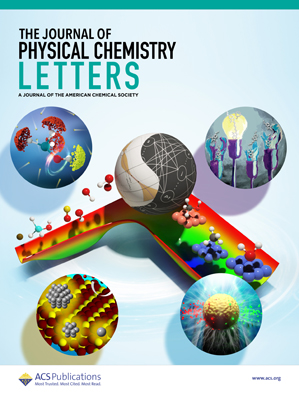Impact of Aspect Ratio on Charge Carrier Dynamics and Efficiency Enhancement in CdSe/CdS Dot-in-Rod Nanostructures for Photocatalytic Hydrogen Evolution
IF 4.6
2区 化学
Q2 CHEMISTRY, PHYSICAL
引用次数: 0
Abstract
We demonstrated that the aspect ratio (AR)-tunable CdSe/CdS dot-in-rod (DiR) nanostructures with quasi-type-II band structure were successively synthesized using the hot injection method. When the AR of CdSe/CdS DiR was tuned from 10 to 37, the exciton localization efficiency along the longitudinal CdS rod shell decreased from 57.9 to 15.1%, resulting in a 5-fold improvement in the efficiency of photocatalytic hydrogen (H2) evolution. The optimal CdSe/CdS DiR exhibited the highest H2 evolution rate of 2.11 mmol·g–1·h–1 at an AR of 29 without any cocatalyst assistance. In situ transient absorption spectroscopy was employed to investigate the interfacial charge carrier dynamics of CdSe/CdS DiR during practical photocatalytic H2 evolution. The findings indicated that the half-life of delocalized electrons on the conduction band along the longitudinal CdS rod shell increases from 11.5 to 20.1 μs as the AR increased, demonstrating that the AR-dependent charge carrier dynamics significantly influences the photoactivity of CdSe/CdS DiR. This study provides valuable and novel insights into the tunability of charge carrier dynamics through AR manipulation in one-dimensional semiconductor nano-heterostructures for solar fuel generation.

宽高比对CdSe/CdS点状棒纳米结构光催化析氢载流子动力学和效率增强的影响
我们证明了用热注入法连续合成了具有准ii型带结构的可调宽高比(AR)的CdSe/CdS点在棒(DiR)纳米结构。当CdSe/CdS DiR的AR值从10调到37时,沿纵向CdS棒壳的激子定位效率从57.9%降低到15.1%,光催化析氢效率提高了5倍。在无助催化剂辅助的情况下,CdSe/CdS最优DiR的H2析出率最高,为2.11 mmol·g-1·h-1。采用原位瞬态吸收光谱研究了CdSe/CdS DiR在实际光催化析氢过程中的界面载流子动力学。结果表明,随着AR的增加,沿CdS棒壳的导带离域电子的半衰期从11.5 μs增加到20.1 μs,表明AR依赖的载流子动力学显著影响CdSe/CdS DiR的光活性。该研究为太阳能燃料发电中一维半导体纳米异质结构中电荷载流子动力学的可调性提供了有价值的新见解。
本文章由计算机程序翻译,如有差异,请以英文原文为准。
求助全文
约1分钟内获得全文
求助全文
来源期刊

The Journal of Physical Chemistry Letters
CHEMISTRY, PHYSICAL-NANOSCIENCE & NANOTECHNOLOGY
CiteScore
9.60
自引率
7.00%
发文量
1519
审稿时长
1.6 months
期刊介绍:
The Journal of Physical Chemistry (JPC) Letters is devoted to reporting new and original experimental and theoretical basic research of interest to physical chemists, biophysical chemists, chemical physicists, physicists, material scientists, and engineers. An important criterion for acceptance is that the paper reports a significant scientific advance and/or physical insight such that rapid publication is essential. Two issues of JPC Letters are published each month.
 求助内容:
求助内容: 应助结果提醒方式:
应助结果提醒方式:


